Srisailam Travel Guide – 2-Day Itinerary of Temples, Caves & Nature Trails
Discover Srisailam with this detailed 2-day itinerary — explore Sri Mallikarjuna Swamy Temple, Pathala Ganga, Akkamahadevi Caves, Sikharam, Octopus Viewpoint & more.
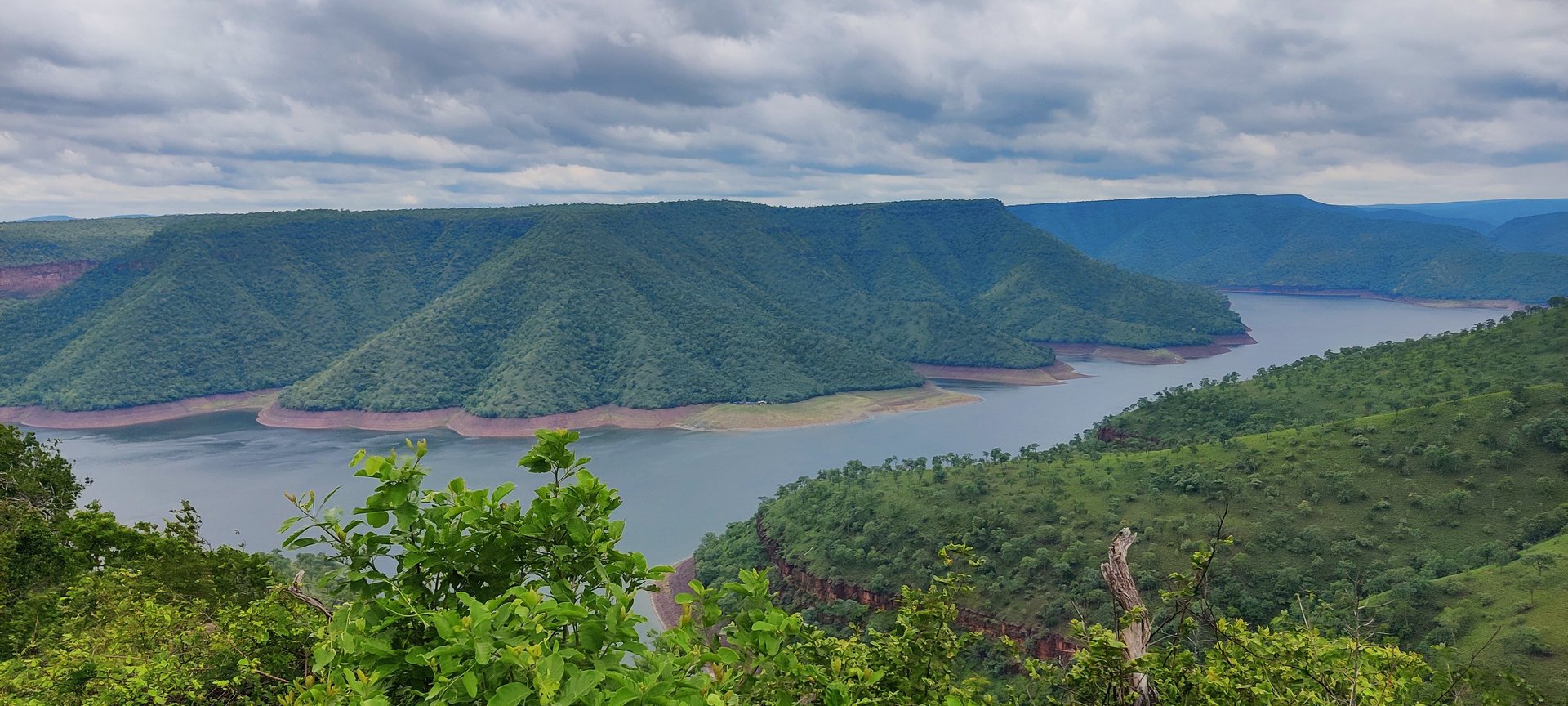
Srisailam in 2 Days:
A Complete Travel Itinerary for Pilgrims and Nature Lovers
Explore temples, forest drives, river views, and more in this well-planned 2-day Srisailam travel itinerary
Srisailam –Where Divinity Meets Nature
Of all the living faiths in the world, Hinduism is one of the oldest—an unbroken stream of beliefs flowing through time. In India, its essence breathes through temples, rituals, and stories passed down through generations. Scattered across the country are countless pilgrimage spots—the Char Dham, the 12 Jyotirlingas, the 51 Shakti Peethas—each echoing with divinity and devotion.
Among them, Srisailam stands as a rare gem. Tucked in the Nallamala Hills of Andhra Pradesh, this ancient temple town is the only place where two powerful shrines—Sri Mallikarjuna Swamy, one of the 12 Jyotirlingas, and Sri Bhramaramba Devi, one of the 51 Shakti Peethas—reside under one sacred roof. It’s not just a temple—it’s a confluence of Shiva and Shakti, of power and peace.
But Srisailam is not just for the devout. The journey here leads you through India’s largest tiger reserve—the Nagarjunsagar-Srisailam Tiger Reserve, a wilderness of 3,700+ square kilometers where nature breathes wild and free. The winding road cuts through dense forest, past monkeys swinging across the canopy and sudden views that take your breath away.
Then comes the Srisailam Dam, built in a deep gorge of the Krishna River. Not just a marvel of engineering, it’s also India’s second-largest working hydroelectric station.
From the stillness of ancient temples to the untamed echo of river gorges, Srisailam lets you experience both worlds. For me, it was always on the bucket list. In July 2024, a wedding brought me to Hyderabad, and I carved out two extra days—for myself, for my soul, for Srisailam.
Whether you're a pilgrim chasing blessings, a traveler chasing views, or a seeker chasing stories, a journey to Srisailam never returns empty.
Updated on: 23rd, June 2025
Explored on: July' 2024
Table of Contents
How to reach Srisailam
Getting to Srisailam is a journey as enriching as the destination itself. Whether you're a pilgrim planning a spiritual retreat or a traveler chasing forested roads, this sacred hill town is well connected by road, rail, and air.
By Road:
The most popular route is by road. APSRTC buses run daily from Hyderabad’s MGBS (Mahatma Gandhi Bus Station) to Srisailam. You can also hire a private cab or taxi for more flexibility and scenic stops along the Nallamala Hills. The drive takes around 4–5 hours.
From Kurnool, it’s about 180 km, a smooth 4-hour journey by car or bus.
By Train:
Though there’s no direct railway station in Srisailam, you can travel to Markapur Road (85 km) or Cumbum (102 km). Both are connected by trains from South Indian cities, followed by a bus or taxi ride to the temple town.
By Air:
For air travelers, Hyderabad International Airport (217 km) is the nearest major hub, well-connected across India. Kurnool Airport (181 km) is a domestic option. Cabs and buses are easily available from both.
No matter which path you choose—road, rail, or sky—all routes to Srisailam lead to something deeper. A journey into the heart of devotion, through forests that whisper and hills that heal.
Best Time to Visit Srisailam
Getting to Srisailam is as enriching as the destination itself. Whether you're a pilgrim planning a spiritual retreat or a traveler seeking forested trails, this sacred town is well-connected.
Winter (October to February)
This is the best season to visit Srisailam. The weather stays cool and pleasant, between 15°C and 25°C—perfect for exploring temples, viewpoints, and forest trails. It’s also the time of Maha Shivaratri, when the Mallikarjuna Temple comes alive with devotion and vibrant rituals.
Monsoon (June to September)
Srisailam turns lush and green under the monsoon spell. With temperatures around 20°C to 28°C, it’s a visual treat for nature lovers and photographers. Waterfalls roar to life, forests glow fresh, and the misty hills offer peaceful escapes. Just carry rain gear, and you’re good to go.
Summer (March to May)
With highs up to 40°C, summer is less popular—but it offers quiet temple visits without the crowds. Early mornings and evenings are still pleasant. The Brahmotsavam Festival in April brings grandeur and devotion to the town. For the crowd-free traveler, it’s a soulful, slower experience.
Where to Stay in Srisailam
When planning a trip, one of the most common questions is “Where to stay in Srisailam?” Since it is both a pilgrimage and a nature getaway, accommodation options cater to different types of travelers.
Temple Guesthouses & Dharamshalas
The Srisailam Devasthanam runs several guesthouses and cottages near the Mallikarjuna Temple.
Budget-friendly and located close to the temple, these are ideal for pilgrims who want easy access for darshan.
You can book directly on the Srisailam Devasthanam official website.
Hotels in Srisailam
There are mid-range hotels and lodges in the town center offering basic amenities.
These are convenient for families who prefer proximity to both the temple and the ropeway/boating point.
Eco-Tourism Stays & Forest Guesthouses
For nature lovers, the Andhra Pradesh Forest Department offers eco-tourism cottages within the Nallamala forest zone.
These provide a unique stay amidst wildlife, close to trekking trails and viewpoints. (Check availability on the Forest Department site).
In the Nallamala Hills, so deep and wide,
Srisailam is called with sacred pride.
Where Mallikarjuna’s temple stands so tall,
And Bhramaramba’s blessings gently fall.
Morning prayers in the temple light,
Whispered peace at dawn's first sight.
Ropeway rides to valleys deep,
Where Pathala Ganga gently sleeps.
Akkamahadevi’s cave stands wide,
With ancient tales in stone to hide.
Shikharam calls with skies so high,
Where soul and mountain meet the sky.
Octopus Viewpoint bids goodbye,
With forest arms and river nigh.
From prayer to path, from trail to time,
Srisailam lives in heart and rhyme.


2-Day Srisailam Itinerary
Since Hyderabad is the most convenient base to reach Srisailam, I followed the same scenic forest route through the Nallamala hills. It’s a journey full of misty views, forest trails, and sacred stops.
Here’s a 2-day Srisailam itinerary—or a perfect weekend guide—covering all key places on the way from Hyderabad and in & around the holy town of Srisailam.
Day 1 Itinerary– Into the Heart of the Hills
Start your journey from Hyderabad to Srisailam early in the morning—ideally before sunrise. Not only does it give you a relaxed pace for the day, but early hours also offer a better chance to spot wildlife in the Nallamala forest—from deer and boars to antelopes wandering near the roadside.
The distance is around 225 km, and it usually takes 4 to 5 hours by road. Take NH 765, a smooth highway that leads you through the changing landscapes of Telangana. First come stretches of green fields and rocky boulder hills, passing towns like Amangal and Dindi, where the real forest charm begins.
About 150 km in, after around 2.5 hours of driving, the flat plains slowly give way to the lush Nallamala Hills. This is where the road becomes scenic and dramatic—with a winding ascent, sharp hairpin bends, and misty forest views all around. It’s the kind of route where the journey becomes just as beautiful as the destination.
Amrabad Tiger Reserve – A Wild Retreat in the Nallamala Forest
As you drive deeper into the Nallamala hills toward Srisailam, a forest gate welcomes you—the entry to Amrabad Tiger Reserve, one of the largest tiger reserves in India. Spread across 2,800 sq km, this protected wilderness in Telangana is home to over 25 majestic tigers, along with leopards, sloth bears, wild dogs, and the elusive pangolin.
Though I couldn’t explore it personally, as my visit was in July during the monsoon when safaris and treks are closed, the forest still felt alive, soaked in green and mystery. If you’re visiting between October to March, you’re in luck. That’s when the weather is clear, wildlife sightings are frequent, and the Amrabad Safari is open for adventurers.
Beyond the safari, the reserve offers much more—forest trekking, visits to the Environmental Education Centre, and even rustic stays in forest cottages. What makes it special is also its people. The Chenchu tribes, who call this forest home, live in harmony with nature, offering a rare glimpse into tribal life in the Nallamala forest.
If you love nature, culture, or just the thrill of spotting stripes between the trees, Amrabad Tiger Reserve is a detour worth making.
Srisailam Dam Views – A Majestic Pause Before the Divine
As the journey continues on the scenic road from Hyderabad to Srisailam, you pass through quiet little hamlets nestled in Telangana’s rolling hills. The road winds gently downhill until you arrive at a bridge over the Krishna River—where nature greets you with an unforgettable pause.
Here, the mighty Krishna flows between two forested hills, marking not just a geographic divide, but a state border—Telangana on one side, Andhra Pradesh on the other. This very gorge is where the iconic Srisailam Dam rises—a marvel of post-independence India and the country’s second-largest hydroelectric power station. It’s also a lifeline, irrigating vast farmlands across the region.
The view from the bridge is breathtaking—Krishna’s waters glimmering below, cradled by green cliffs of the Nallamala forest. As you ascend once again towards the temple town of Srisailam, a few viewpoints offer stunning glimpses of the dam and river valley. Even though the dam gates were closed during my monsoon visit, the sight still left me in awe.
A rare blend of natural charm and engineering brilliance, Srisailam Dam stands as a symbol of balance—between devotion and development, between the wild and the built.
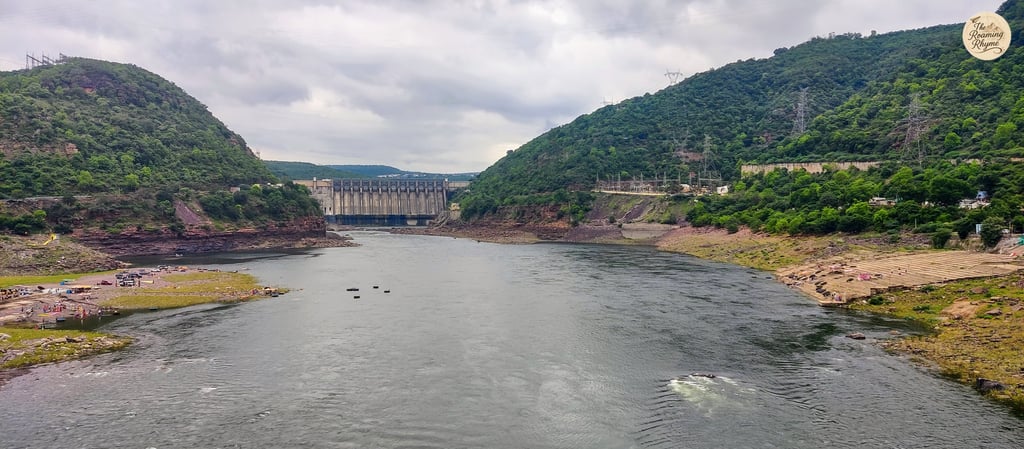

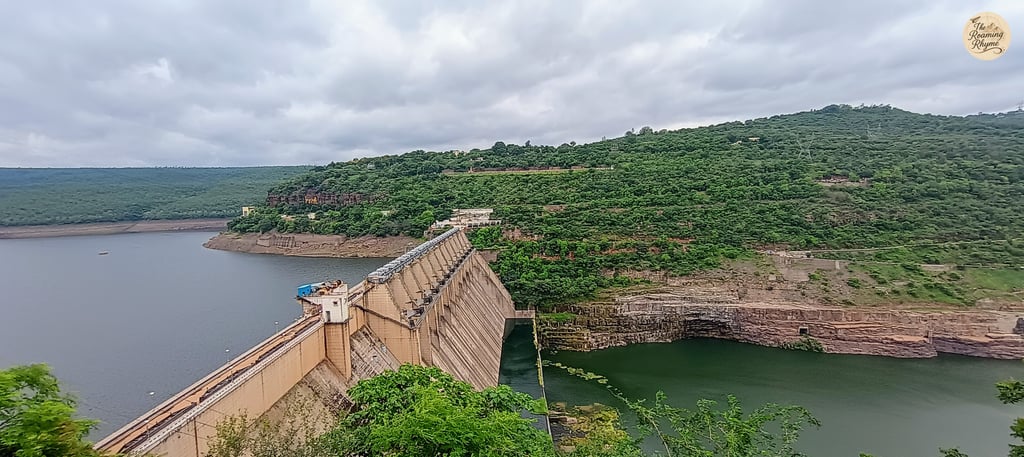

View of Srisailam Dam - where the Krishna River meets an engineering marvel.
Scenic view of Srisailam Dam and the Krishna River from above.
Paladhara Panchadhara – Sacred Streams and Mystic Vibes
Just 4 km before reaching the sacred town of Srisailam, take a soulful detour to Paladhara Panchadhara—a serene and scenic stream hidden down a flight of mossy stairs. As you descend, you’ll spot fortune tellers with parrots in cages—ready to pluck a card that might reveal your future. It’s quirky, curious, and oddly captivating.
At the base, several crystal-clear streams merge into a cool, whispering flow amidst the lush greens of the Nallamala forest. The name "Paladhara Panchadhara" comes from Lord Shiva himself—‘Pala’ meaning forehead, and ‘Dhara’ meaning stream, believed to have originated from Shiva’s divine form.
More than just nature’s beauty, this spot carries deep spiritual weight. In the 8th century, Sri Adi Shankaracharya meditated here and composed the powerful Sivananda Lahari, dedicated to Lord Mallikarjuna. A small shrine with idols of Shankaracharya and Goddess Sharada still draws devotees seeking peace before stepping into the divine town.
Hathakesvara Temple: A Quiet Chapter in Srisailam’s Sacred Tale
Just a few steps from Paladhara Panchadara, you’ll find Hathakesvara Temple, a serene shrine dedicated to Lord Shiva. Modest in size but deep in spiritual significance, this temple is known for its open-pillared mukha-mandapa and ancient Shiva lingam enshrined within the sanctum. Its architecture reflects timeless simplicity, inviting you to pause and reflect.
This is also the place where Sri Adi Shankaracharya, the revered philosopher and saint, is believed to have composed one of his key texts—making it a notable spot on Srisailam’s sacred map.
The legend adds a deeper layer: a humble potter, known for feeding pilgrims, once found himself without food. Saddened, he offered a heartfelt prayer to Shiva. Touched by his devotion, the Lord appeared in the form of a pot. Thus, the place came to be known as Atikeswaram—Atika meaning a piece of pot—which evolved into Hatakeswaram Temple over time.
It may not be grand in size, but Hathakesvara leaves behind a gentle imprint on every pilgrim's path.
Sakshi Ganapati Temple – The Divine Check-In Before Darshan
Just a few minutes’ drive before reaching the temple town of Srisailam, the Sakshi Ganapati Temple stands quietly by the roadside, yet it holds a deeply significant place in every pilgrim’s journey.
This modest temple, dedicated to Lord Ganesha, is more than just a stop—it’s a sacred witness. As the name suggests, Sakshi means "witness", and it is believed that Lord Ganapati keeps a record of every devotee visiting the sacred Mallikarjuna Jyotirlinga. The black idol inside, with a stylus in one hand and a scripture in the other, symbolizes this celestial bookkeeping.
Traditionally, pilgrims first stop here to register their names and gotra before proceeding to the main temples of Srisailam. The belief goes that without offering prayers at the Sakshi Ganapati Temple, your visit to Mallikarjuna Swamy remains incomplete.
Though small in size, the temple’s walls are adorned with intricate carvings, and the energy here feels calm, focused, and welcoming—like a silent nod before the grand darshan ahead.
Sri Mallikarjuna Swamy and Bhramaramba Devi Temple
Once you arrive in the sacred town of Srisailam, settle into your stay, freshen up, and get ready to visit the spiritual heart of the region—Sri Mallikarjuna Swamy Temple. This ancient shrine is one of the 12 Jyotirlingas of Lord Shiva and draws pilgrims from all across India. The main deity, Lord Mallikarjuna Swamy, is believed to be self-manifested, radiating divine energy from the sanctum.
Right beside him stands Goddess Bhramaramba Devi, one of the 51 Shakti Peethas, making this temple a rare confluence of both Jyotirlinga and Shakti Peetha in one sacred complex.
The legends of Sri Mallikarjuna Swamy Temple are steeped in divine stories and timeless devotion. According to mythology, when Lord Shiva and Goddess Parvati sought brides for their sons, Ganesha was married to Riddhi and Siddhi, symbols of wisdom and spiritual strength. When Kartikeya returned and found Ganesha already wed, he felt betrayed and chose a life of solitude at Mount Krauncha in Palani, taking the vow of a Kumara Brahmachari. Shiva and Parvati followed to console him, but Kartikeya stayed distant. On the request of the gods, he settled nearby. The divine couple chose to stay on this sacred hill, which came to be known as Srisailam.
Here, Shiva was worshipped with Mallika flowers (jasmine), giving him the name Mallikarjuna—the Lord of Jasmine.
Centuries later, this sacred site would draw the reverence of great kings, too. Chhatrapati Shivaji Maharaj, deeply devoted to Lord Shiva, visited the shrine and supported its restoration, leaving a lasting mark on the temple’s spiritual legacy.
This ancient temple is not just a shrine but a sacred sprawl, housing two main deities: Lord Mallikarjuna and Goddess Bhramaramba Devi. Alongside these powerful shrines, the complex is adorned with pillared mandapams and smaller sanctums like Vriddha Mallikarjuna, Sahasra Lingeswara, Ardhanariswara, Veerabhadra, and Uma Maheswara—each holding its own spiritual essence.
A massive stone wall encircles the complex with four grand gateways (dwaras), the Maha Dwaram on the east being the main entrance. Just past it, a majestic mandapam with 42 intricately carved pillars welcomes you. At its heart sits the grand sculpture of Nandi, silently gazing toward his Lord.
At the inner sanctum, the temple opens into the Mukha Mandapa, leading to the Antarala, and finally to the Garbhagriha—the sanctified core where the self-manifested Mallikarjuna Jyotirlinga rests. The design is classic Dravidian, with spiritual energy flowing through every carved corner.
The temple comes alive during Maha Shivaratri Brahmotsavam, Ugadi, and Navaratri, when devotion flows like a river and every pillar hums with spiritual energy. Visiting during these vibrant festivals adds a deeper joy to your darshan.
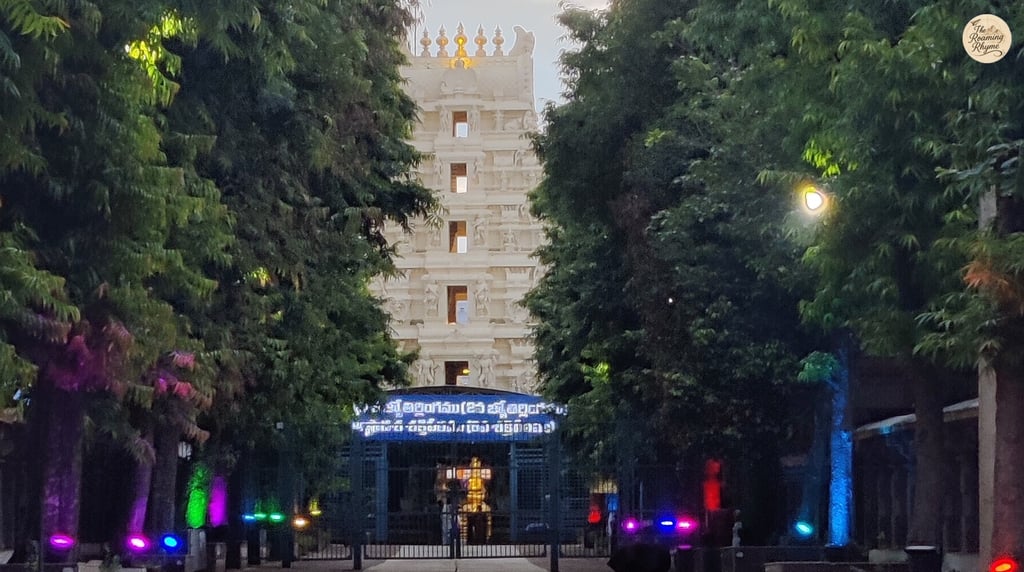

Mallikarjuna Temple - A sacred Jyotirlinga shrine surrounded by ancient architecture and spiritual calm.
Chenchu Lakshmi Tribal Museum – A Glimpse into Tribal Life
If you're looking to go beyond temples and step into the cultural roots of Srisailam, the Chenchu Lakshmi Tribal Museum is worth a visit. Located near the entrance of the town, this museum offers a fascinating glimpse into the lives of the indigenous tribes of the Nallamala forests — especially the Chenchu tribe, who have lived in harmony with nature for centuries.
Named after Chenchu Lakshmi, the consort of Lord Narasimha Swamy, the museum also features her statue, symbolizing the deep bond between tribal life and devotion. Spread over two floors, the museum displays traditional tools, weapons, musical instruments, and idols that once shaped daily life in the jungle.
Don’t forget to stop by the local honey shop — here, you can buy organic forest honey collected by the tribes and supported by the government.
Step into this quiet corner of Srisailam and walk through stories carved in wood, stone, and soul.
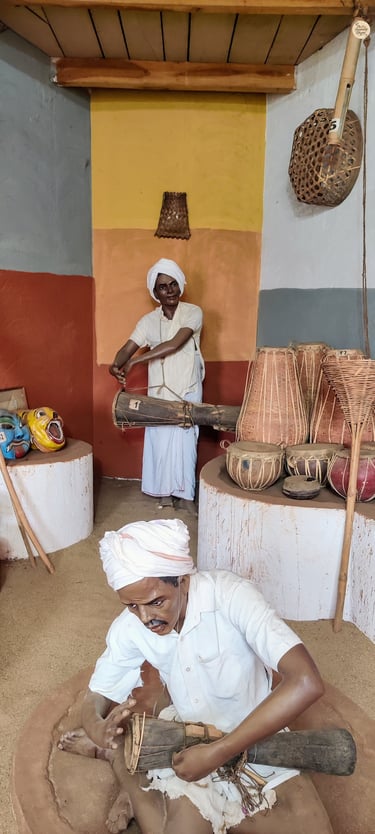

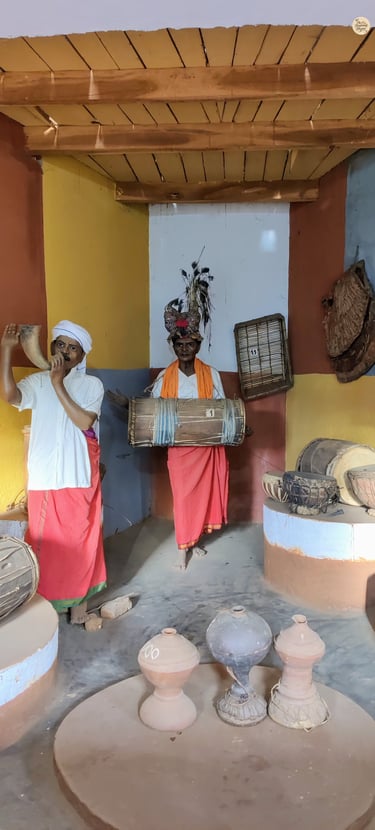

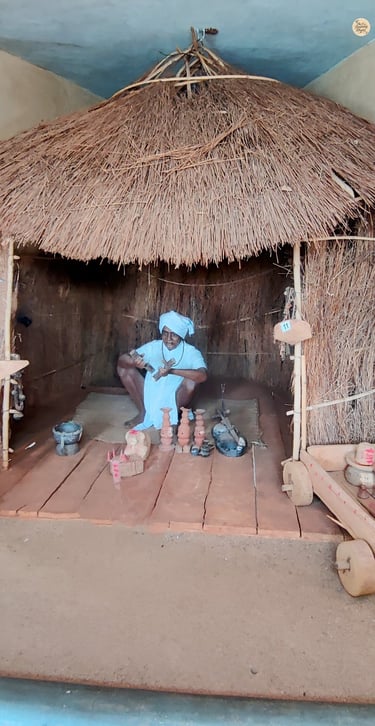

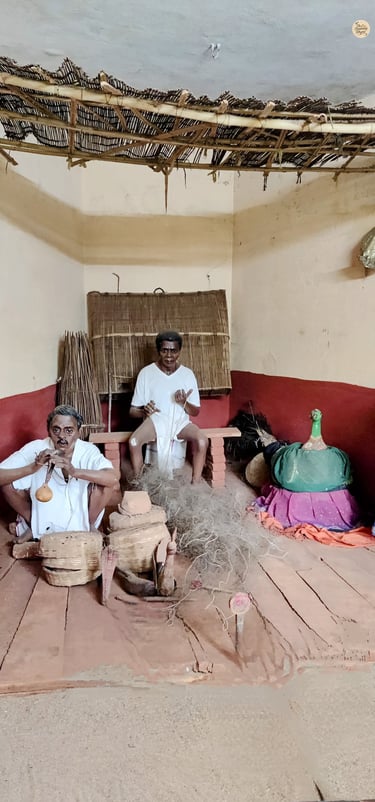

A cultural window into Srisailam's tribal communities - Chenchu Lakshmi Museum visit.
Day 2 Itinerary – Adventure and Sacred Sights in Srisailam
After a peaceful first day in Srisailam filled with spiritual calm, Day 2 brings a gentle thrill. This day is all about blending nature, adventure, and devotion in perfect harmony.
Begin your morning with a soulful darshan at Sri Mallikarjuna Swamy Temple, followed by a ropeway ride down to the sacred Pathala Ganga. From here, set sail on a boat journey to the mystical Akkamahadevi Caves. Later, rise to the heights of Shikharam, the highest viewpoint around Srisailam, offering panoramic views of the lush Nallamala forests.
With every turn, Day 2 promises to awaken not just your senses — but your spirit too.
Wake Up to Divinity – Early Morning Visit to Sri Mallikarjuna Temple
If you can rise with the sun, let your day begin where the divine resides — at the Sri Mallikarjuna Swamy Temple. The temple doors open at 6 AM, and this is when the air is calm, the crowds are few, and the devotion flows quietly.
An early morning darshan of Lord Mallikarjuna Swamy and Goddess Bhramaramba Devi is the perfect way to start your day in Srisailam. With no rush, you can stand in peace, absorb the energy of the self-manifested Jyotirlinga, and admire the powerful presence of the Devi.
As golden light filters through the ancient pillars, you’ll get a chance to appreciate the intricate carvings, the sacred silence, and the spiritual rhythm of this magnificent temple. A moment of stillness, before the world begins — just you and the divine.
After your peaceful morning darshan and a hearty breakfast, it’s time to step into the next chapter of your Srisailam journey. Freshen up, pack your curiosity, and head towards Pathala Ganga, where the sacred Krishna River winds through the valley.
Pathala Ganga – Ropeway Views and Boat Rides in the Heart of Srisailam
Tucked behind the mighty Srisailam Dam, Pathala Ganga is where the sacred River Krishna flows through the deep green folds of the Nallamala Hills. With calm waters and hills all around, this sacred spot feels like a prayer in motion.
Pilgrims come here to take a holy dip — the waters are believed to purify the soul. But even beyond the faith, it’s the calm rhythm of the river and the scenic valley views that make this place unforgettable.
You can either descend around 500 steps from the Hanuman Temple or choose the scenic ropeway ride from the Haritha Hotel. At the ropeway center, don’t forget to pick up your round-trip tickets — not just for the ropeway ride, but also for the enchanting boat journey to Akkamahadevi Caves that begins from here. As you glide down, the views are magical — the blue-green backwaters, the dam’s vast gates, and the quiet hills stretching far into the horizon.
Pathala Ganga is not just a place for prayer, but also the gateway to adventure — with boat rides that begin here, taking you deeper into Srisailam’s secrets, like the mystical Akkamahadevi Caves.
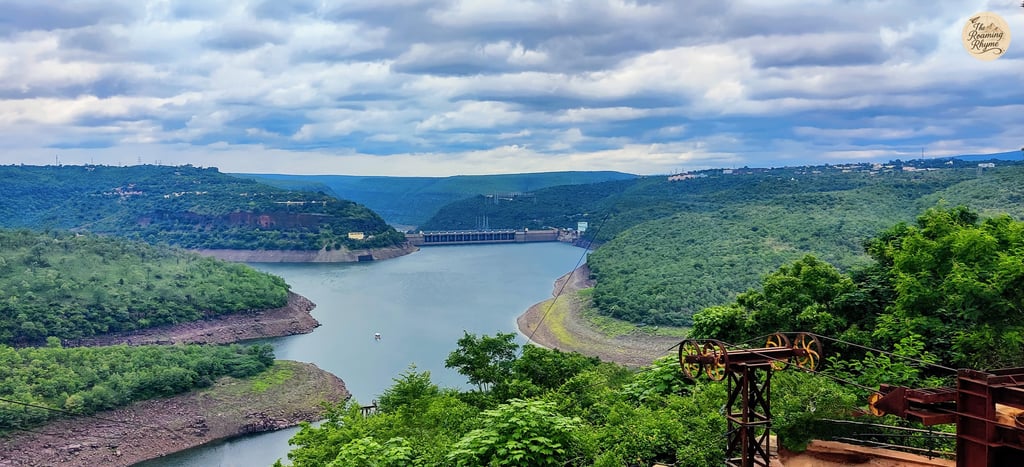

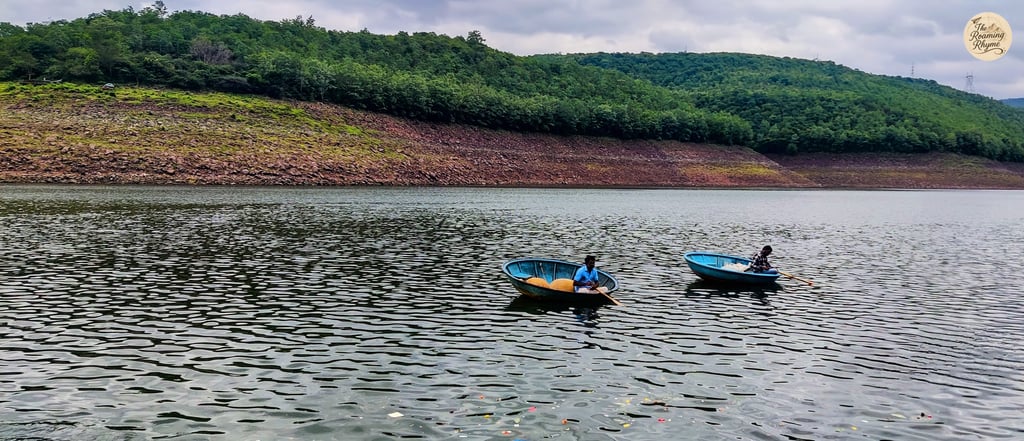

From above Pathalganga - panoramic view of Srisailam Dam and its vast reservoir.
Fishermen in coracles over the Krishna River - captured from Pathalganga.
Akkamahadevi Caves – A Boat Ride to Srisailam’s Mystical Depths
After soaking in the calm of Pathala Ganga, let your spirit drift toward adventure — to the mystical Akkamahadevi Caves, located about 18 km from Srisailam. These ancient caves, dedicated to Lord Shiva, are carved by nature and steeped in legends of devotion and solitude.
To reach the caves, you begin with a one-hour boat ride on the Krishna River, where the still waters and forested banks offer a peaceful pause. As your boat glides through the gorge, the world quiets down — setting the mood for the marvel ahead.
Once docked, a short forest walk leads you to a breathtaking stone arch — the natural gateway to the caves. The journey into the cave is narrow and dark, lit only by torches, adding a sense of mystery to the experience. As you carefully make your way inside, the space tightens, and you’ll need to bend and crawl to reach the inner sanctum where a naturally formed Shiva Lingam rests in silence.
These caves are named after Akka Mahadevi, a 12th-century saint and poetess who is believed to have meditated here. Her spiritual energy still lingers in the cool darkness of this ancient sanctuary.
Outside, a few humble stalls offer tea and snacks — a warm reward after your little trek. Akkamahadevi Caves are open all day, but boat rides begin around 10:30 AM, so plan your visit early for the full experience.
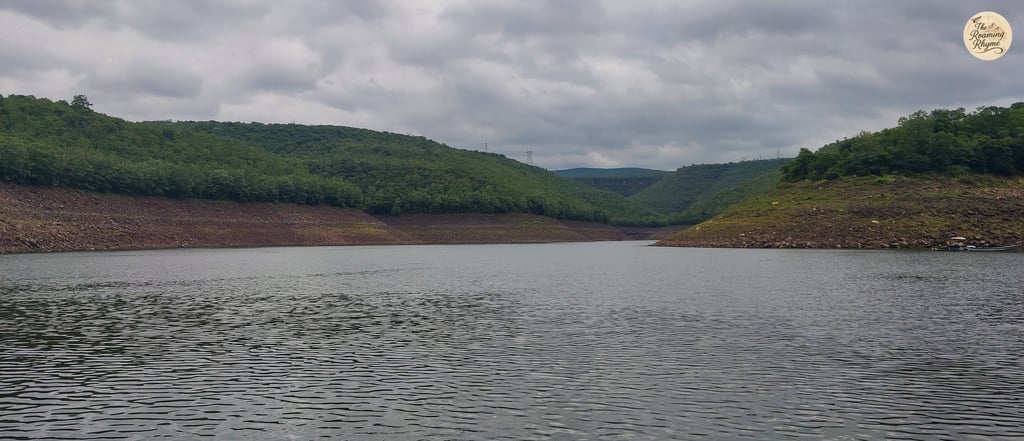

Calm Krishna River between Nallamala Hills - en route to Akkamahadevi Caves.
Sikharam – Touching the Sky at Srisailam’s Highest Point
As you journey back from Srisailam towards Hyderabad, make a meaningful pause just 8 km away — at Sikharam, the highest point of the Srisailam Hills, standing tall at 2,830 feet above sea level.
Wrapped in silence and sacred air, Sikharam offers more than just a view — it offers a moment of reflection. According to the Skanda Purana, a single glance at this peak is believed to free the soul from the cycle of rebirth. In ancient times, pilgrims who couldn’t reach the temple would bow here, letting their devotion rise with the hills.
At the summit sits the Sikhareswaram Temple, a quiet stone shrine dedicated to Veera Sankara Swamy, lovingly known as Sikhareswara Swamy. Built in 1398 AD by the Reddy Kings, the temple features an age-old Pushkarini (sacred tank) and stone-pillared mandapa — still standing strong against the winds of time.
From here, take in a panoramic view of Srisailam, with the Krishna River curling gracefully below and the temple complex rising in timeless beauty.
It’s a spot where sky meets soul, and nature bows before faith.
Octopus Viewpoint – Nature’s Farewell Embrace to Srisailam
As you drive back from Srisailam towards Hyderabad, make one last magical stop — the Octopus Viewpoint, just 36 km away. Nestled deep within the Nagarjunasagar-Srisailam Tiger Reserve, this scenic spot is truly Mother Nature’s sculpture, a breathtaking blend of wild beauty and quiet wonder.
From above, the winding River Krishna glimmers like silk, while lush green forests stretch out like the arms of an octopus — giving this spot its unique name. It’s a panoramic view that stirs the soul, where mountains embrace the sky and the breeze whispers a soft goodbye.
To reach this hidden gem, park your vehicle outside and enjoy a 400-meter walk along a stone trail. As you arrive, a shaded viewpoint welcomes you with open arms, offering a peaceful perch to soak in the serenity. The views here are simply poetic — a wide canvas of hills, river bends, and the symphony of silence only nature can compose.
The viewpoint open from 10 AM to 5 PM, So be sure to arrive on time — no entry is allowed after the last hour. There are no shops around, so carry your own water and snacks, and above all, respect the forest’s quiet guardians — the flora, fauna, and the fragile balance they live in.
Whether you're a nature lover, a photo-seeker, or simply a wanderer at heart, this viewpoint is the perfect place to pause, breathe, and bid farewell to your Srisailam journey. Let the soft wind kiss your face, the green valleys calm your thoughts, and the vastness of the view remind you just how vast and beautiful the world can be.
Octopus Viewpoint isn’t just a stop — it’s a soulful goodbye, written in the language of nature.
And once the final glimpse settles in your heart, it's time to begin the journey home. Do plan your descent wisely — the Hyderabad–Srisailam Highway passes through dense forest and the tiger reserve, and it remains closed at night. So start your drive back well before dusk to ensure a safe and peaceful return to Hyderabad.
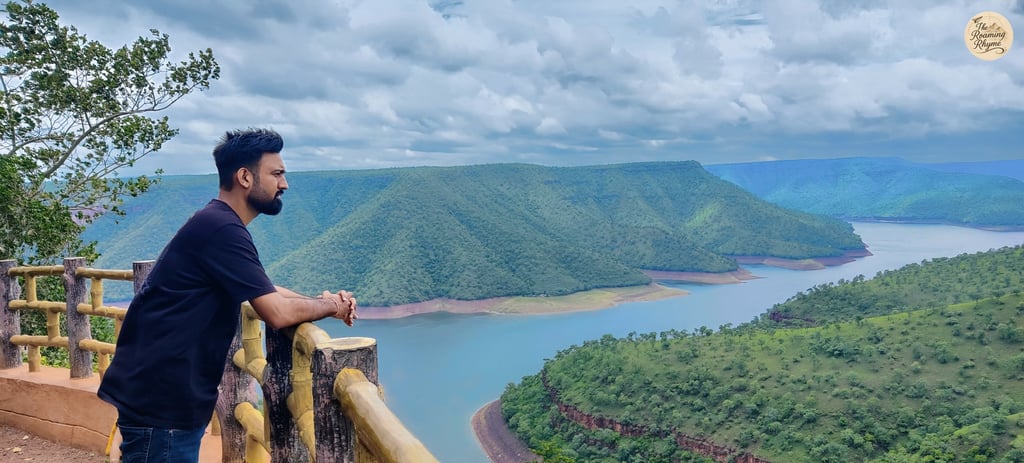

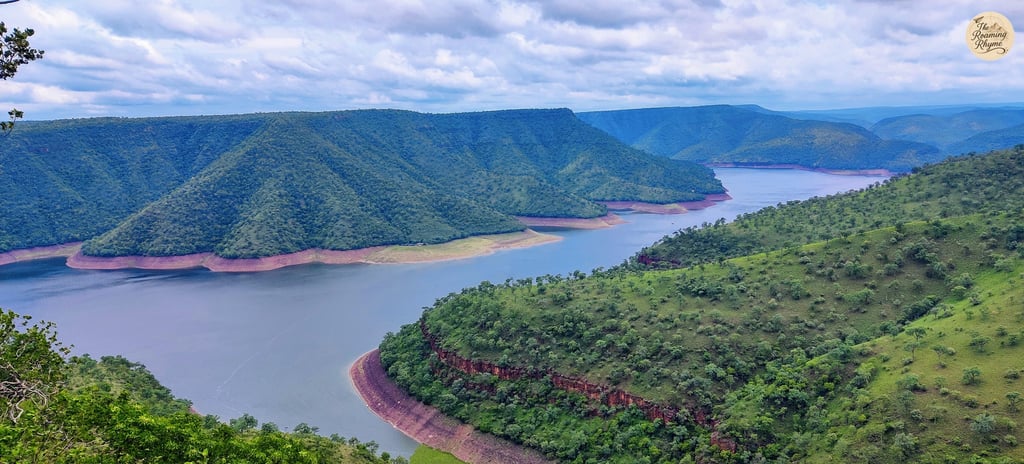

Admiring the panoramic beauty of Octopus View Point - a refreshing stop near Srisailam.
Octopus Viewpoint - where cliffs curve, winds whisper, and Srisailam stuns in silence.
What to Eat in Srisailam – A Pilgrim’s Food Trail
Food in Srisailam isn’t just about filling your stomach — it’s about devotion, tradition, and the warmth of Andhra hospitality. From temple meals to market flavours, here’s what you must try:
Breakfast Stop at Mannanur – Hot & Hearty
On your forest drive up to Srisailam, take a pit stop at Mannanur.
Must-try: Andhra-style aloo bonda with strong Hyderabadi Dum Chai.
Don’t miss the soft idlis with triple chutneys – simple, fresh, and soul-hugging.
Temple Meals – Nithya Annadanam at Mallikarjuna Temple
By noon, after darshan, head to the temple’s Nithya Annadanam hall.
Free meals, served daily by the Devasthanam Trust.
Simple, wholesome food eaten side by side with fellow pilgrims — a soulful reminder of sharing and community.
Lunch & Dinner in Srisailam – Where to Eat After Darshan
After exploring temples, caves, or the forest, Srisailam has some comforting food stops waiting for you.
Rajdhani Restaurant (Near Bus Stand): A great lunch option where you can dig into Andhra staples like Pulihora (tamarind rice) and Pesarattu (green gram dosa). Light, tasty, and satisfying for a mid-day meal. Don’t forget to pick up some local sweets and savouries from the nearby market stalls.
Trishul Restaurant: Perfect for dinner after a long day of darshan or boat rides. Their Andhra Thali — complete with rice, sambar, rasam, curries, pickles, papad, and dessert — is wholesome and filling. Pair it with refreshing buttermilk for a true homely finish.
Best Photography Spots in Srisailam
Srisailam is more than just a spiritual retreat — it’s a visual canvas painted with rivers, hills, caves, and ancient temples. Here are the top spots to capture its beauty:
Octopus Viewpoint – Capture the Krishna River curving like an octopus amidst the green Nallamala hills.
Srisailam Dam – A majestic frame of engineering brilliance with vast backwaters reflecting golden sunsets.
Sikharam – The highest point of Srisailam, offering panoramic views of temples, forests, and valleys.
Akkamahadevi Caves – Mystical limestone caves reachable by boat, perfect for dramatic low-light shots.
Pathala Ganga Ropeway – A thrilling ride over the Krishna River with aerial views worth framing forever.
From the divine darshan at Sri Mallikarjuna Swamy Temple to the calm waters of Pathala Ganga, from the thrilling boat ride to Akkamahadevi Caves to the panoramic views at Shikharam and Octopus Viewpoint — this trip to Srisailam was a blend of spirituality, nature, and soft adventure.
Whether it was strolling through the temple market, tasting local Andhra flavors, or soaking in the silence of the hills, Srisailam offered more than just sights — it offered soulful stillness.
This sacred hill town leaves you lighter, calmer, and a little closer to something divine. If you’ve ever longed for a journey that whispers peace and paints poetry across your path, Srisailam might just be that escape.
Frequently Asked Questions – Srisailam Travel Guide
Q. What is Srisailam famous for?
A. Srisailam is famous for the ancient Mallikarjuna Swamy Temple, which is one of the twelve Jyotirlingas (sacred abodes of Lord Shiva) and the Bhramaramba Devi Temple, a significant Shakti Peetha (shrine for the Goddess Shakti).
Q. How many days are enough to visit Srisailam?
A. Ideally, two days are enough to cover all the major tourist attractions of Srisailam.
Q. What is the best time to visit Srisailam?
A. The best time to visit Srisailam is during the winter months, from October to February, due to pleasant weather and moderate temperatures.
Q. Which temple to visit first in Srisailam?
A. You should visit the Sakshi Ganapati Temple first in Srisailam as a traditional practice to ensure your pilgrimage to the main Sri Mallikarjuna Swamy Temple is recorded by Lord Ganesha, who witnesses the presence of all devotees.
Q. Is photography allowed in the temples?
A. No, photography is not permitted inside the temple sanctum. You can click photos in the outside areas.
Q. Is lungi compulsory in Srisailam?
A. No, lungi/pancha is not necessary unless you are performing abhishekam or special poojas; otherwise, for darshan, formals are allowed. Still, at the main temple, you have to remove your upper clothing and do the darshan; women have to wear a salwar suit or saree.
Q. Which part of Devi fell in Srisailam?
A. The neck of Sati is believed to have fallen in the sacred site of Srisailam, making the temple renowned as Bramaramba Sakthi Peeth, the sixth among the 18 Sakthi Peethas.
Q. What is Sparsha Darshan in Mallikarjuna?
A. Sparsha Darshan at the Mallikarjuna Temple in Srisailam is a rare and sacred opportunity for devotees to physically touch the Jyotirlinga of Lord Mallikarjuna Swamy and receive direct blessings.
Q. What is the price of the ropeway in Pathala Ganga Srisailam?
A. The ticket price for the Patal Ganga ropeway in Srisailam is Rs. 71 per person. There are also combo tickets available that include ropeway, boating, and access to the Akkamahadevi caves.
Q. How to visit Akkamahadevi Caves?
A. To visit Akkamahadevi Caves near Srisailam, you must take a ropeway to Pathala Ganga, then a boat ride on the Krishna River to reach the vicinity of the caves, followed by a short 10-minute trek to the caves themselves.
Q. What is the Akkamahadevi boat ride cost and timing?
A. The Akka Mahadevi boat ride costs around ₹330 to ₹350 per person and typically starts around 10:30 AM. Tickets are often sold from around 9 AM, and it's best to arrive early.
Q. Why is it called an octopus viewpoint?
A. Octopus View Point has been named so because of the Krishna River down below that looks like an octopus spread between the hillocks. It provides a spectacular bird's-eye view of the entire valley below.
Share Your Thoughts – We’d Love to Hear From You!
Every journey is better when shared.
We hope you enjoyed this travel story — now, we'd love to hear yours! Share your experience, suggestions, or feedback and help us make our travel tales even better.
